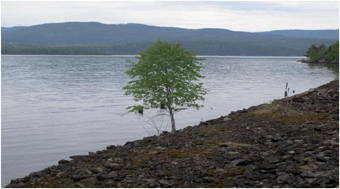当前位置:
X-MOL 学术
›
Environ. Sci.: Processes Impacts
›
论文详情
Our official English website, www.x-mol.net, welcomes your feedback! (Note: you will need to create a separate account there.)
Transfer of naturally occurring radionuclides from soil to wild forest flora in an area with enhanced legacy and natural radioactivity in Norway.
Environmental Science: Processes & Impacts ( IF 5.5 ) Pub Date : 2020-01-15 , DOI: 10.1039/c9em00408d Jelena Mrdakovic Popic 1 , Deborah H Oughton 2 , Brit Salbu 2 , Lindis Skipperud 2
Environmental Science: Processes & Impacts ( IF 5.5 ) Pub Date : 2020-01-15 , DOI: 10.1039/c9em00408d Jelena Mrdakovic Popic 1 , Deborah H Oughton 2 , Brit Salbu 2 , Lindis Skipperud 2
Affiliation

|
A study of transfer of naturally occurring radioactive materials (NORM), thorium, uranium and their progeny, from soil to wild plant species was performed to evaluate the environmental impact in an area of enhanced natural and legacy radioactivity in Norway. Three sites were chosen for the study: NORM legacy mining, undisturbed 232Th-rich site and reference site. Tissue concentrations, transfer factors and radiation exposure doses were determined in nine wild plant species. High soil activity concentrations of NORM, statistically indistinguishable, were measured at legacy NORM and undisturbed 232Th-rich sites, respectively, while soil from the reference site exhibited a statistically lower activity concentration. Heterogeneous soil radionuclide distributions were observed. The mobile soil fraction of investigated radionuclides was significantly lower, but properly reflected in measured plant uptake. Plant tissue activity concentrations of NORM were significantly higher at both investigated 232Th-rich sites in comparison to the reference site and varied per plant species and analyzed radionuclide, for instance, from non-detectable 232Th in tree needles and leaves to significantly elevated values of measured 210Po in lichens. As expected, plant roots served as a natural translocation barrier, as the concentration of radionuclides in the analyzed samples was up to 88-fold higher than that in the corresponding aboveground plants. Transfer factors for 232Th, 238U, 226,228Ra and 210Po in the aboveground plants ranged broadly from 4 × 10-5 to 1 × 10-2; 1 × 10-4 to 4 × 10-2, 1.07 × 10-3 to 1.08; 2.18 × 10-2 to 9.53 × 10-2 and 9.18 × 10-2 to 9.69, respectively. Radiological exposure dose rates, calculated using the ERICA tool and site-specific data, were from 1 to 23 μGy h-1. Due to elevated NORM levels in analyzed plants, measured radiation exposure dose rates were higher than those of worldwide background biota. Still, the uptake of NORM, demonstrated in the current study, is not expected to cause significant changes at population levels in wild plant species.
中文翻译:

在挪威遗产和自然放射性增强的地区,天然放射性核素从土壤转移到野生森林植物区系。
进行了将天然放射性物质(NORM),or,铀及其后代从土壤转移到野生植物物种的研究,以评估挪威自然和遗留放射性增强的区域对环境的影响。选择了三个站点进行研究:NORM传统采矿,未受干扰的232Th站点和参考站点。确定了9种野生植物物种的组织浓度,转移因子和辐射暴露剂量。在传统NORM和未受干扰的富含232Th的地点分别测得了高土壤活性NORM浓度,在统计学上无法区分,而来自参考地点的土壤则显示出统计学较低的活性浓度。观测到非均质的土壤放射性核素分布。所研究的放射性核素的可移动土壤分数显着降低,但在所测量的植物吸收中得到了适当的反映。与参考位点相比,在调查的富含232Th的位点上,植物组织活性的NORM浓度均显着较高,并且随植物种类的不同而变化,并分析了放射性核素,例如,从树针和树叶中未检测到的232Th到测量值的显着升高210Po地衣。不出所料,由于分析样品中放射性核素的浓度比相应的地上植物高88倍,因此植物的根部成为天然的易位屏障。地上植物中232Th,238U,226,228Ra和210Po的转移因子范围从4×10-5到1×10-2。1×10-4至4×10-2、1.07×10-3至1.08; 2.18×10-2至9。53×10-2和9.18×10-2至9.69。使用ERICA工具和特定地点的数据计算出的放射线照射剂量率为1至23μGyh-1。由于分析植物中NORM的水平升高,因此测得的辐射暴露剂量率高于全世界本底生物群。尽管如此,目前的研究表明,摄取NORM不会导致野生植物种群水平的显着变化。
更新日期:2020-02-26
中文翻译:

在挪威遗产和自然放射性增强的地区,天然放射性核素从土壤转移到野生森林植物区系。
进行了将天然放射性物质(NORM),or,铀及其后代从土壤转移到野生植物物种的研究,以评估挪威自然和遗留放射性增强的区域对环境的影响。选择了三个站点进行研究:NORM传统采矿,未受干扰的232Th站点和参考站点。确定了9种野生植物物种的组织浓度,转移因子和辐射暴露剂量。在传统NORM和未受干扰的富含232Th的地点分别测得了高土壤活性NORM浓度,在统计学上无法区分,而来自参考地点的土壤则显示出统计学较低的活性浓度。观测到非均质的土壤放射性核素分布。所研究的放射性核素的可移动土壤分数显着降低,但在所测量的植物吸收中得到了适当的反映。与参考位点相比,在调查的富含232Th的位点上,植物组织活性的NORM浓度均显着较高,并且随植物种类的不同而变化,并分析了放射性核素,例如,从树针和树叶中未检测到的232Th到测量值的显着升高210Po地衣。不出所料,由于分析样品中放射性核素的浓度比相应的地上植物高88倍,因此植物的根部成为天然的易位屏障。地上植物中232Th,238U,226,228Ra和210Po的转移因子范围从4×10-5到1×10-2。1×10-4至4×10-2、1.07×10-3至1.08; 2.18×10-2至9。53×10-2和9.18×10-2至9.69。使用ERICA工具和特定地点的数据计算出的放射线照射剂量率为1至23μGyh-1。由于分析植物中NORM的水平升高,因此测得的辐射暴露剂量率高于全世界本底生物群。尽管如此,目前的研究表明,摄取NORM不会导致野生植物种群水平的显着变化。


























 京公网安备 11010802027423号
京公网安备 11010802027423号